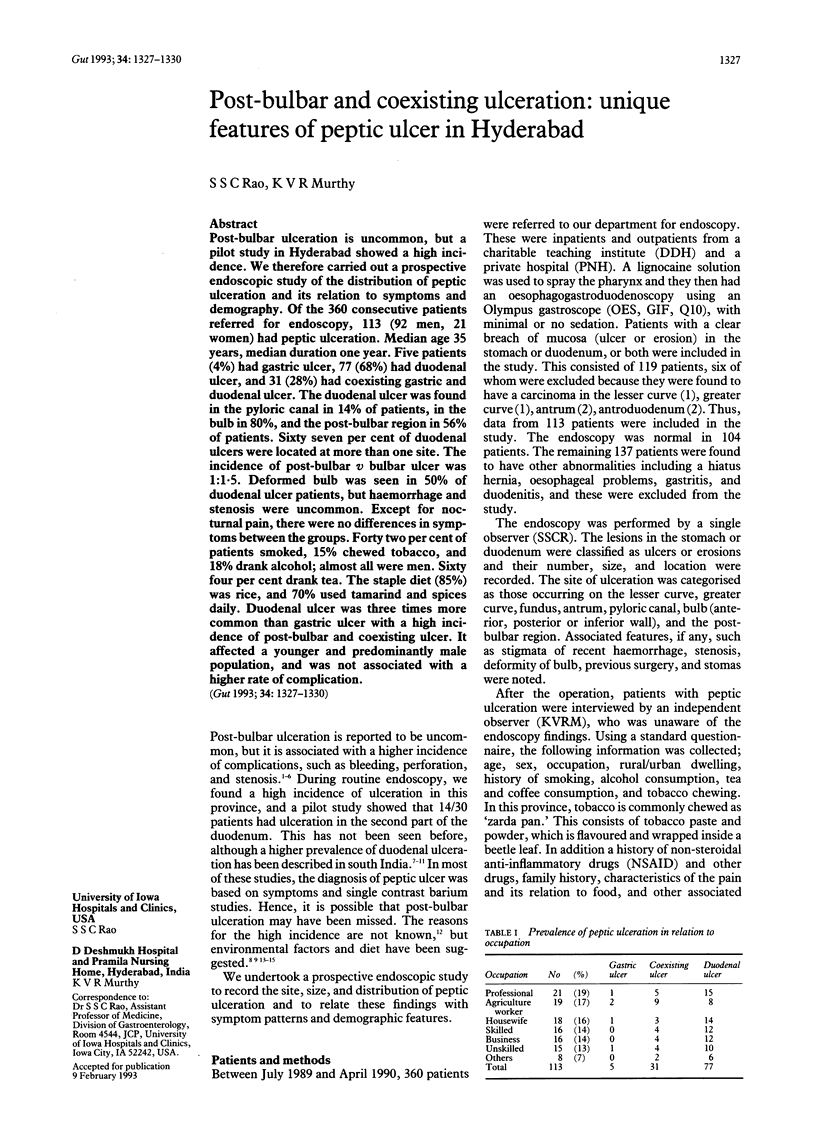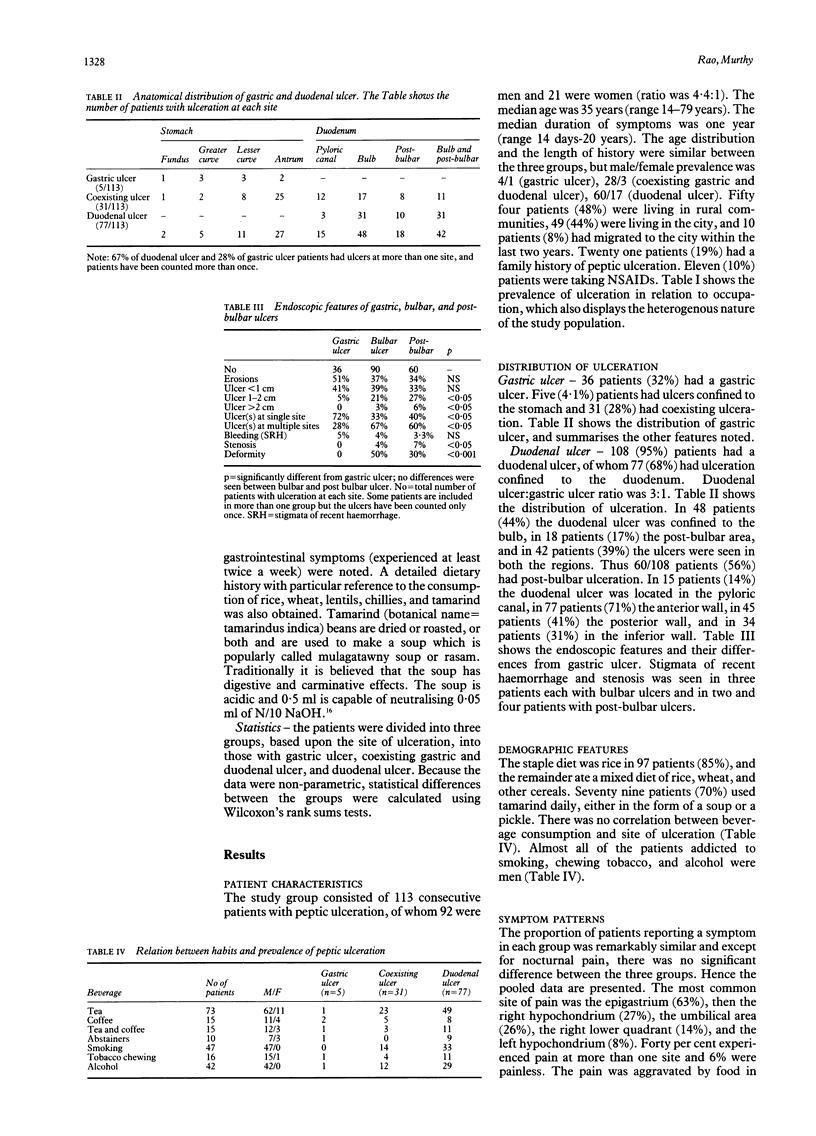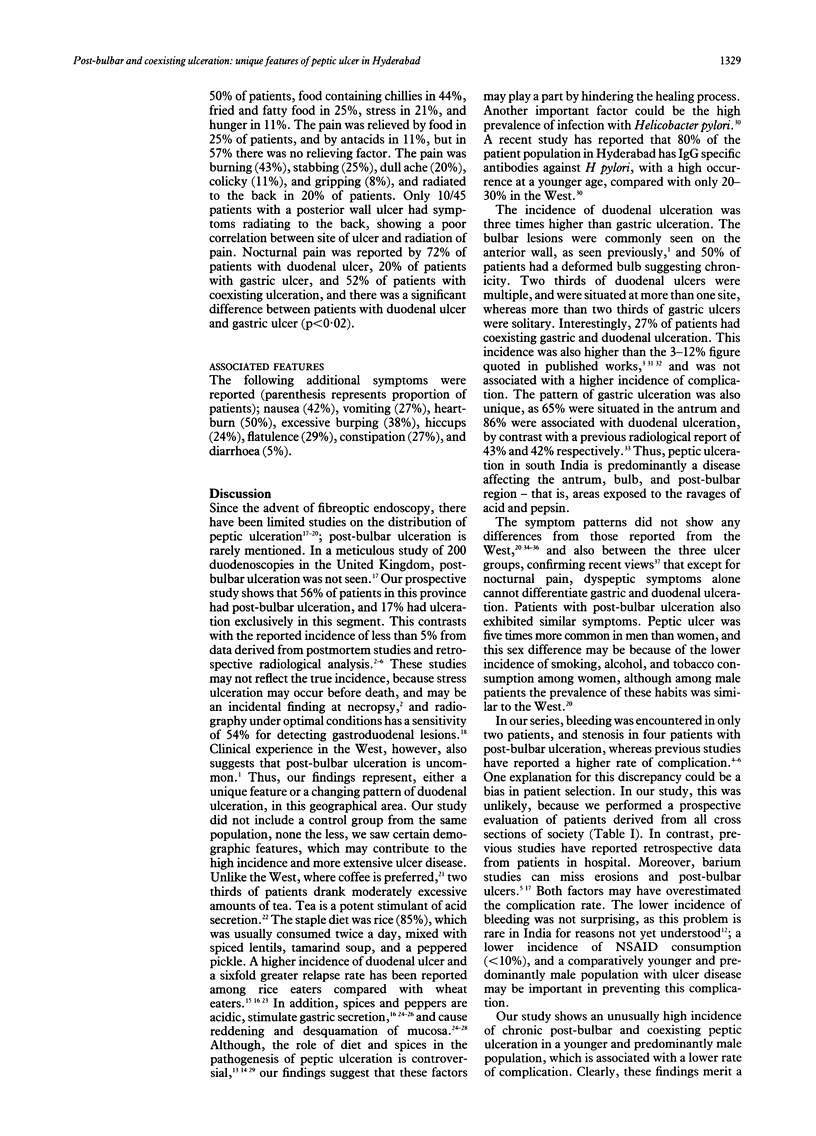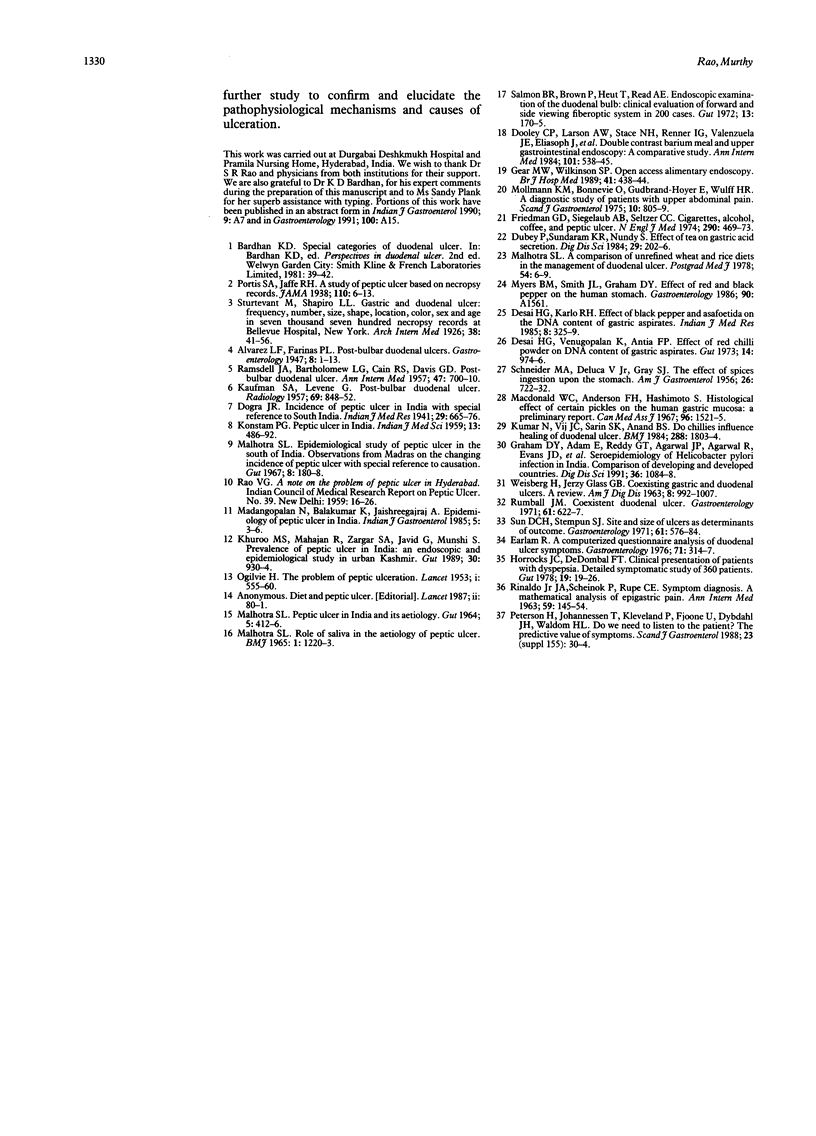Abstract
Post-bulbar ulceration is uncommon, but a pilot study in Hyderabad showed a high incidence. We therefore carried out a prospective endoscopic study of the distribution of peptic ulceration and its relation to symptoms and demography. Of the 360 consecutive patients referred for endoscopy, 113 (92 men, 21 women) had peptic ulceration. Median age 35 years, median duration one year. Five patients (4%) had gastric ulcer, 77 (68%) had duodenal ulcer, and 31 (28%) had coexisting gastric and duodenal ulcer. The duodenal ulcer was found in the pyloric canal in 14% of patients, in the bulb in 80%, and the post-bulbar region in 56% of patients. Sixty seven per cent of duodenal ulcers were located at more than one site. The incidence of post-bulbar v bulbar ulcer was 1:1.5. Deformed bulb was seen in 50% of duodenal ulcer patients, but haemorrhage and stenosis were uncommon. Except for nocturnal pain, there were no differences in symptoms between the groups. Forty two per cent of patients smoked, 15% chewed tobacco, and 18% drank alcohol; almost all were men. Sixty four per cent drank tea. The staple diet (85%) was rice, and 70% used tamarind and spices daily. Duodenal ulcer was three times more common than gastric ulcer with a high incidence of post-bulbar and coexisting ulcer. It affected a younger and predominantly male population, and was not associated with a higher rate of complication.
Full text
PDF



Selected References
These references are in PubMed. This may not be the complete list of references from this article.
- DELUCA V., Jr, GRAY S. J., SCHNEIDER M. A. The effect of spice ingestion upon the stomach. Am J Gastroenterol. 1956 Dec;26(6):722–732. [PubMed] [Google Scholar]
- Desai H. G., Kalro R. H. Effect of black pepper & asafoetida on the DNA content of gastric aspirates. Indian J Med Res. 1985 Mar;81:325–329. [PubMed] [Google Scholar]
- Desai H. G., Venugopalan K., Antia F. P. Effect of red chilli powder on DNA content of gastric aspirates. Gut. 1973 Dec;14(12):974–976. doi: 10.1136/gut.14.12.974. [DOI] [PMC free article] [PubMed] [Google Scholar]
- Dooley C. P., Larson A. W., Stace N. H., Renner I. G., Valenzuela J. E., Eliasoph J., Colletti P. M., Halls J. M., Weiner J. M. Double-contrast barium meal and upper gastrointestinal endoscopy. A comparative study. Ann Intern Med. 1984 Oct;101(4):538–545. doi: 10.7326/0003-4819-101-4-538. [DOI] [PubMed] [Google Scholar]
- Dubey P., Sundram K. R., Nundy S. Effect of tea on gastric acid secretion. Dig Dis Sci. 1984 Mar;29(3):202–206. doi: 10.1007/BF01296252. [DOI] [PubMed] [Google Scholar]
- Earlam R. A computerized questionnaire analysis of duodenal ulcer symptoms. Gastroenterology. 1976 Aug;71(2):314–317. [PubMed] [Google Scholar]
- Friedman G. D., Siegelaub A. B., Seltzer C. C. Cigarettes, alcohol, coffee and peptic ulcer. N Engl J Med. 1974 Feb 28;290(9):469–473. doi: 10.1056/NEJM197402282900901. [DOI] [PubMed] [Google Scholar]
- Gear M. W., Wilkinson S. P. Open-access upper alimentary endoscopy. Br J Hosp Med. 1989 May;41(5):438, 440, 442-4. [PubMed] [Google Scholar]
- Graham D. Y., Adam E., Reddy G. T., Agarwal J. P., Agarwal R., Evans D. J., Jr, Malaty H. M., Evans D. G. Seroepidemiology of Helicobacter pylori infection in India. Comparison of developing and developed countries. Dig Dis Sci. 1991 Aug;36(8):1084–1088. doi: 10.1007/BF01297451. [DOI] [PubMed] [Google Scholar]
- Horrocks J. C., De Dombal F. T. Clinical presentation of patients with "dyspepsia". Detailed symptomatic study of 360 patients. Gut. 1978 Jan;19(1):19–26. doi: 10.1136/gut.19.1.19. [DOI] [PMC free article] [PubMed] [Google Scholar]
- KAUFMAN S. A., LEVENE G. Postbulbar duodenal ulcer. Radiology. 1957 Dec;69(6):848–852. doi: 10.1148/69.6.848. [DOI] [PubMed] [Google Scholar]
- KONSTAM P. G. Peptic ulcer in India. Indian J Med Sci. 1959 Jun;13(6):486–492. [PubMed] [Google Scholar]
- Khuroo M. S., Mahajan R., Zargar S. A., Javid G., Munshi S. Prevalence of peptic ulcer in India: an endoscopic and epidemiological study in urban Kashmir. Gut. 1989 Jul;30(7):930–934. doi: 10.1136/gut.30.7.930. [DOI] [PMC free article] [PubMed] [Google Scholar]
- Kumar N., Vij J. C., Sarin S. K., Anand B. S. Do chillies influence healing of duodenal ulcer? Br Med J (Clin Res Ed) 1984 Jun 16;288(6433):1803–1804. doi: 10.1136/bmj.288.6433.1803. [DOI] [PMC free article] [PubMed] [Google Scholar]
- MALHOTRA S. L. PEPTIC ULCER IN INDIA AND ITS AETIOLOGY. Gut. 1964 Oct;5:412–416. doi: 10.1136/gut.5.5.412. [DOI] [PMC free article] [PubMed] [Google Scholar]
- MALHOTRA S. L., SAIGAL O. N., MODY G. D. ROLE OF SALIVA IN THE AETIOLOGY OF PEPTIC ULCER. Br Med J. 1965 May 8;1(5444):1220–1222. doi: 10.1136/bmj.1.5444.1220. [DOI] [PMC free article] [PubMed] [Google Scholar]
- MacDonald W. C., Anderson F. H., Hashimoto S. Histological effect of certain pickles on the human gastric mucosa. A preliminary report. Can Med Assoc J. 1967 Jun 10;96(23):1521–1525. [PMC free article] [PubMed] [Google Scholar]
- Malhotra S. L. A comparison of unrefined wheat and rice diets in the management of duodenal ulcer. Postgrad Med J. 1978 Jan;54(627):6–9. doi: 10.1136/pgmj.54.627.6. [DOI] [PMC free article] [PubMed] [Google Scholar]
- Malhotra S. L. Epidemiological study of peptic ulcer in the south of India. Observations from Madras on the changing incidence of peptic ulcer, with special reference to causation. Gut. 1967 Apr;8(2):180–188. doi: 10.1136/gut.8.2.180. [DOI] [PMC free article] [PubMed] [Google Scholar]
- Möllmann K. M., Bonnevie O., Gudbrand Höyer E., Wulff H. R. A diagnostic study of patients with upper abdominal pain. Scand J Gastroenterol. 1975;10(8):805–809. [PubMed] [Google Scholar]
- OGILVIE H. The problem of peptic ulceration. Lancet. 1953 Mar 21;1(6760):55–60. [PubMed] [Google Scholar]
- Petersen H., Johannessen T., Kleveland P. M., Fjøsne U., Dybdahl J. H., Waldum H. L. Do we need to listen to the patient? The predictive value of symptoms. Scand J Gastroenterol Suppl. 1988;155:30–36. doi: 10.3109/00365528809096278. [DOI] [PubMed] [Google Scholar]
- RAMSDELL J. A., BARTHOLOMEW L. G., CAIN J. C., DAVIS G. D. Postbulbar duodenal ulcer. Ann Intern Med. 1957 Oct;47(4):700–710. doi: 10.7326/0003-4819-47-4-700. [DOI] [PubMed] [Google Scholar]
- RINALDO J. A., Jr, SCHEINOK P., RUPE C. E. SYMPTOM DIAGNOSIS. A MATHEMATICAL ANALYSIS OF EPIGASTRIC PAIN. Ann Intern Med. 1963 Aug;59:145–154. doi: 10.7326/0003-4819-59-2-145. [DOI] [PubMed] [Google Scholar]
- Rumball J. M. The Veterans Administration Cooperative Study on Gastric Ulcer. 7. Coexistent duodenal ulcer. Gastroenterology. 1971 Oct;61(4 Suppl):622–627. [PubMed] [Google Scholar]
- Salmon P. R., Brown P., Htut T., Read A. E. Endoscopic examination of the duodenal bulb: clinical evaluation of forward- and side-viewing fibreoptic systems in 200 cases. Gut. 1972 Mar;13(3):170–175. doi: 10.1136/gut.13.3.170. [DOI] [PMC free article] [PubMed] [Google Scholar]
- Sun D. C., Stempien S. J. The Veterans Administration Cooperative Study on Gastric Ulcer. 3. Site and size of the ulcer as determinants of outcome. Gastroenterology. 1971 Oct;61(4 Suppl):576–584. [PubMed] [Google Scholar]
- WEISBERG H., GLASS G. B. COEXISTING GASTRIC AND DUODENAL ULCERS; A REVIEW. Am J Dig Dis. 1963 Dec;8:992–1007. doi: 10.1007/BF02239491. [DOI] [PubMed] [Google Scholar]


